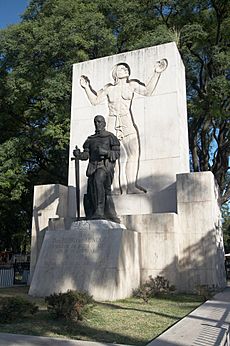Pedro de Mendoza facts for kids
Quick facts for kids
Pedro de Mendoza y Luján
|
|
|---|---|

Monument to Pedro de Mendoza, Parque Lezama, neighborhood of San Telmo, Buenos Aires, Argentina.
|
|
| Born | c. 1487 Guadix, Granada, Spain
|
| Died | 23 June 1537 (aged 49–50) |
| Occupation | Spanish Conquistador |
Pedro de Mendoza y Luján (born around 1487 – died June 23, 1537) was a Spanish explorer and soldier. He was known as a conquistador, which means a Spanish conqueror. He became the first adelantado (a special governor) of a region called New Andalusia.
Contents
Setting Sail for a New World
Pedro de Mendoza came from an important family in Guadix, Spain. He was well-liked by Emperor Charles V. In 1524, he became a knight.
In 1529, Mendoza offered to explore South America using his own money. He also wanted to start new settlements there. In 1534, the Emperor agreed to his plan. Mendoza was made a special governor and military leader for a large area. This area was called New Andalusia. He could claim any land he conquered within a certain distance.
The Emperor gave Mendoza 2,000 men and 13 ships. Mendoza promised to bring 1,000 settlers within two years. He also agreed to build roads and three forts.
In 1534, Mendoza set sail with his large fleet. A big storm scattered his ships near Brazil. During this time, his assistant, Juan de Osorio, was killed. Some people believe Mendoza ordered his death.
Mendoza sailed up the Río de la Plata in 1535. On February 2, 1536, he founded the city of Buenos Aires.
Even though Mendoza founded Buenos Aires, he was often sick. He tried his best to lead the expedition. A German soldier named Ulrico Schmidl wrote about this time. Schmidl came with Mendoza and stayed for 18 years. He fought in many battles. His writings are very important for understanding this early history.
Facing Challenges with Local People
Near the River Plata, the Spanish met a group of about 3,000 native people called the Querandíes. These natives shared their food with the Spanish, even though food was scarce.
However, the Spanish soon took the natives' kindness for granted. Because of this, the Querandíes stopped helping them. They moved further away from the Spanish settlement. Mendoza was angry about this. He sent his brother to lead a fight against the natives.
In a battle near the Luján River, many natives were killed. But Mendoza's brother was also killed, along with 30 of his men and several horses. The natives were forced to leave, and the Spanish took their food. This battle was very costly for the Spanish.
Tough Times in the New City
The settlers built a wall around their city. It was made of mud and was about 1 meter (3 feet) thick. But every time it rained, parts of the wall would wash away.
The colonists also faced a big problem: hunger. Food became very hard to find. People had to eat rats, mice, snakes, lizards, and even old leather boots to survive.
To make things worse, different native groups joined together. They attacked the city many times. Often, the city was almost completely burned down. Mendoza was still very sick. He chose Juan de Ayolas to take over as the main leader.
Ayolas decided to sail up the Parana River with many of the remaining soldiers. They fought and defeated the Guaraní people. They then made a peace agreement with them. In 1537, Ayolas founded the city of Asunción in what is now Paraguay.
Mendoza's Journey Home
While Ayolas was exploring, Mendoza was very disappointed and unwell. He decided to sail back to Spain in 1537. Sadly, he died during the trip across the Atlantic Ocean.
Mendoza had promised to send help to the people he left in Buenos Aires. In his will, he asked Spain to send more men and supplies. But the help that arrived was not enough.
In 1541, the settlers left Buenos Aires. They moved to Asunción instead. Domingo Martínez de Irala was chosen as the new leader there. With Buenos Aires in ruins, Asunción became the main base for Spanish efforts in the Rio de la Plata region.
Images for kids
-
Buenos Aires shortly after its foundation by Pedro de Mendoza (drawing from the book of Ulrico Schmidl, a member of the expedition, 1536).
See also
 In Spanish: Pedro de Mendoza para niños
In Spanish: Pedro de Mendoza para niños


